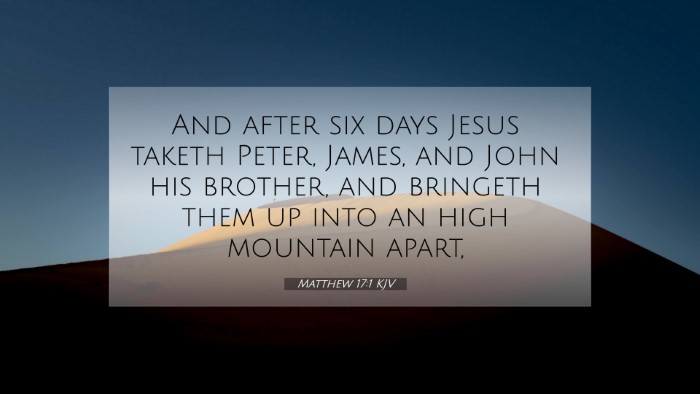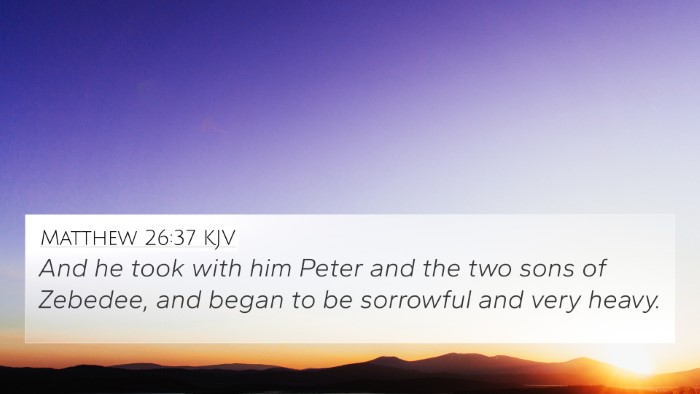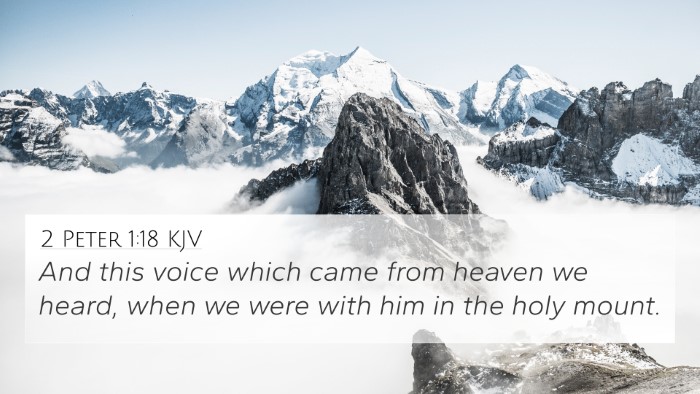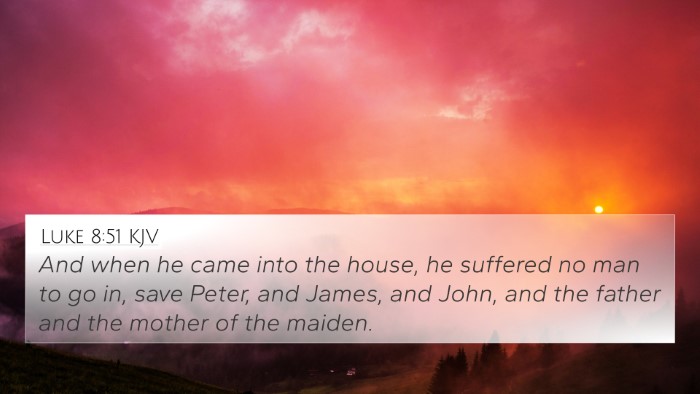Understanding Matthew 17:1
Verse Text: “And after six days Jesus taketh Peter, James, and John his brother, and bringeth them up into an high mountain apart.”
Overview of the Verse
This verse marks the beginning of the transfiguration narrative, where Jesus reveals His divine glory to three of His closest disciples. This event significantly illustrates the connection between the Old Testament prophetic tradition and the New Testament revelation of Christ’s nature.
Commentary Insights
- Matthew Henry: The six days indicate a period of preparation and reflection, a time of anticipation for the disciples. The choice of disciples emphasizes their special relationship with Jesus and their role in the early church.
- Albert Barnes: The mention of the mountain signifies a setting apart for spiritual revelation—it symbolizes the closeness to God. Mountains in scripture often represent places of divine encounter.
- Adam Clarke: Clarke emphasizes the significance of the selected disciples, noting their future leadership roles. He also indicates that the high mountain setting serves as a metaphor for spiritual elevation and divine revelation.
Thematic Analysis
This verse introduces themes of exclusivity and divine revelation, with the mountain scene serving as a backdrop for significant theological truths. The gathering of Peter, James, and John also points to the importance of community in spiritual experiences.
Bible Verse Cross-References
Several scriptures connect deeply with Matthew 17:1, offering a rich tapestry of understanding through cross-referencing:
- Exodus 24:15-18: Moses also ascended a mountain for divine revelation, establishing a pattern seen in Christ's transfiguration.
- Luke 9:28-36: This parallel account provides additional details about the transfiguration, further deepening our understanding of the event.
- Mark 9:2-8: Another synoptic reference that emphasizes the same core themes and events.
- Matthew 4:8: Jesus’ earlier temptation on the mountain establishes a contrast between worldly power and divine authority.
- 1 Peter 1:16-18: Reminds believers of the divine majesty seen in Jesus, connecting to the glory revealed during the transfiguration.
- Revelation 1:16: The imagery of Christ's face shines like the sun, echoing the transfiguration’s emphasis on His divine nature.
- Matthew 16:13-17: The previous revelation of Peter's confession of Christ's identity lays the groundwork for the later confirmation at the mountain.
Connections Between Bible Verses
Exploring Matthew 17:1 invites us to consider several connections:
- Linking Jesus’ divine authority in Matthew 28:18 with the majesty displayed during transfiguration helps define His messianic role.
- Connecting this event with Romans 8:18-19 allows reflection on the glory of God that will be revealed in believers.
- Examining the high mountain setting alongside Isaiah 2:2 reveals its significance in prophetic vision and worship.
Bible Cross-Reference Tools
As you delve deeper into Bible verse analysis, consider these tools for cross-referencing:
- Bible concordance for locating related verses quickly.
- Cross-reference Bible study guides that can help illuminate connections.
- Comprehensive Bible reference resources for thematic studies.
Conclusion
Matthew 17:1 is a pivotal scripture not only for its immediate context but also for the theological implications it presents. As we engage in comparative Bible verse analysis and identify inter-Biblical dialogues, we gain a fuller understanding of who Jesus is, His relationship to the Old Testament, the nature of revelation, and the role of His closest disciples. This exploration can deepen our spiritual insights and enrich our study of the Scriptures.









